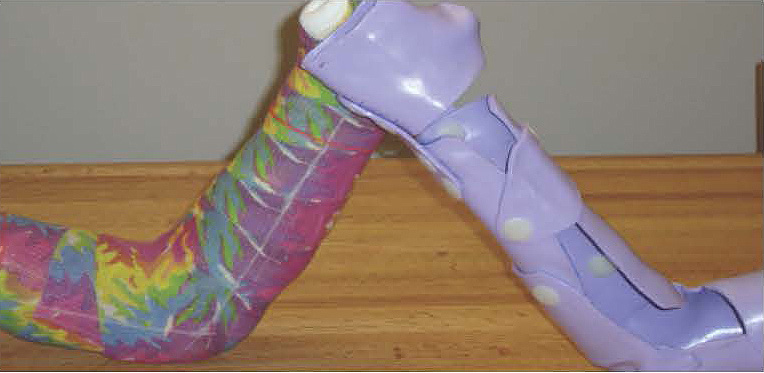Four University of Virginia biomedical engineering students received an Invention Award from the National Collegiate Inventors and Innovators Alliance for their group work on inventing and testing the “PuzzleCast,” a new way of casting a broken arm that allows the arm to save muscle mass while healing.
The year before, the alliance awarded the group a $10,000 grant to test the PuzzleCast on people who wore one for several weeks.
The students – Daniel Amante, Amanda Harton, Kelly Anderson and Clara Tran – all graduated in May from the School of Engineering and Applied Science. But their work will go on. They plan to continue working on the PuzzleCast and hope to see their idea in clinics and on the market within the next three years.
The PuzzleCast consists of six pieces that can be removed individually over time as a broken arm heals.
Traditional casts do not allow the muscles in a broken arm to exercise within the cast, causing the arm to lose a significant amount of its muscle mass. PuzzleCast aims to change that. Since the pieces can be taken off, the broken bone remains stabilized while allowing the arm muscles freedom of movement, reducing the risk of atrophy. This also allows the arm to recover more quickly once the cast has been removed completely.
The students came up with the idea during their biomedical engineering capstone course. They were asked to solve a problem in the medical field and settled on muscle atrophy after immobilization. The inspiration came from a shared background of experiencing muscle atrophy, or watching others experience it.
“The inspiration we needed to solve the problem had been all around us throughout our high school careers,” Amante said. “Teammate Kelly Anderson and I had injuries from high school that had stopped us from being able to participate in high school athletics as often as we would have liked.”
Harton saw injured soccer teammates suffer through a traditional cast followed by muscle atrophy. Tran worked with the elderly and saw similar problems.
“The actual idea for PuzzleCast came after a long brainstorming session,” Harton said. “Originally it was kind of a joke: a cast made out of pieces that fit together like a puzzle. But as we analyzed our other solutions and spoke with doctors, we realized that a modular cast was actually a good idea.”
Now that the group has tested their cast and developed a fully functioning model, they have filed for a patent and are hoping to be able to get the PuzzleCast on the market.
“We are in the process of setting up a non-injured patient pilot study to test and refine our designs. If all goes well after that testing and several more rounds of testing, we hope to license the product,” Amante said.
They are also working on making PuzzleCast for other parts of the body.
“This whole process has taught me more than I ever could have imagined,” Harton said. “Over the past three years we have not only gained experience in the engineering design process, but also in pitching out ideas, applying for grants and filing for a patent.”
“When we started college, none of us expected that we would be meeting with companies to license an idea we had, working through getting a patent, heading to inventors’ conferences, getting thousands of dollars in grants, or being pictured in Popular Science,” Amante said of the experience. “We have definitely learned much about the patent landscape in the United States. We've made our fair share of mistakes along the way, but we’ve learned too. We iterated the design by doing research into the field, checking out the state of the art, talking to experts in orthopedics and making physical prototypes.”
Media Contact
Article Information
August 30, 2012
/content/students-puzzlecast-solves-problem-muscle-atrophy-broken-arm

